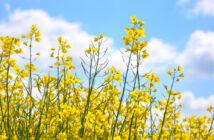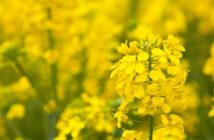With most oilseed rape well through flowering, growers should now be on the lookout for Seed weevil activity. Some hard late April frosts across large parts of the country could result in some early pod abortion on flowering raceme, so protecting remaining pods will be essential for crops to make best use of this season’s high potential.
Cabbage seed weevil make a hole in a pod to lay an egg, but which then allows the Pod midge to access the pod laying several eggs per pod and up to 60 eggs in their lifetime. The resulting feeding larvae can be far more damaging, warned Syngenta Insecticide Field Technical Manager, Max Newbert.
Max pointed out that the Seed weevil itself causes relatively little damage, by laying just one egg per pod, that typically only destroy one or two seeds per pod. However, the Pod midge uses the hole left by the weevil and its larvae will effectively destroy the entire pod’s yield by causing pod shatter.
He highlighted that the relatively cool April meant Seed weevil migration from overwintering sites in hedgerows and margins had been slow so far, but as soon as conditions warm up crop invasion will increase. The threshold for treatment is just one Seed weevil per plant for the main OSR growing areas.
“Treatments must be timed to target the adult weevil,” he advised. “If you can prevent that initial pod damage it will also minimise the impact of Pod midge.” Max advocated Hallmark Zeon treatment at the full rate of 75 ml/ha would provide an instant hit on in-crop weevils and repellence activity to dissuade migration.
“In sunny conditions, the UV protection of Hallmark Zeon formulation can give extended activity and protection of the crop not seen with other lambda products,” he added. “That could prove essential where Seed weevil migration may go on for several weeks, and especially this season where there will be a potentially beneficial long post-flowering green crop area.”
The Seed weevil treatment timing would also give control of any Pod midge in the crop, although growers can make a separate Hallmark Zeon treatment for Pod midge before the end of flowering if required. The threshold assessment for treatment of Pod midge would depend on the extent of Seed weevil pod holes.
Pods that have already set on main raceme will be relatively safe from frost effects, but side shoots and later flowering plants may have been particularly effected, said Max. A series of warm days and cold nights appears to be especially stressful for crops and could result in poor pod set, he added.




